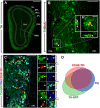Adult Born Olfactory Bulb Dopaminergic Interneurons: Molecular Determinants and Experience-Dependent Plasticity
- PMID: 27199651
- PMCID: PMC4858532
- DOI: 10.3389/fnins.2016.00189
Adult Born Olfactory Bulb Dopaminergic Interneurons: Molecular Determinants and Experience-Dependent Plasticity
Abstract
The olfactory bulb (OB) is a highly plastic brain region involved in the early processing of olfactory information. A remarkably feature of the OB circuits in rodents is the constitutive integration of new neurons that takes place during adulthood. Newborn cells in the adult OB are mostly inhibitory interneurons belonging to chemically, morphologically and functionally heterogeneous types. Although there is general agreement that adult neurogenesis in the OB plays a key role in sensory information processing and olfaction-related plasticity, the contribution of each interneuron subtype to such functions is far to be elucidated. Here, we focus on the dopaminergic (DA) interneurons: we highlight recent findings about their morphological features and then describe the molecular factors required for the specification/differentiation and maintenance of the DA phenotype in adult born neurons. We also discuss dynamic changes of the DA interneuron population related to age, environmental stimuli and lesions, and their possible functional implications.
Keywords: COUP-TFI; adult neurogenesis; dopaminergic neurons; juxtaglomerular neurons; odor deprivation; odor enrichment; olfactory bulb; tyrosine hydroxylase.
Figures

Similar articles
-
COUP-TFI controls activity-dependent tyrosine hydroxylase expression in adult dopaminergic olfactory bulb interneurons.Development. 2013 Dec;140(24):4850-9. doi: 10.1242/dev.089961. Epub 2013 Nov 13. Development. 2013. PMID: 24227652
-
The Functional Role of Olfactory Bulb Granule Cell Subtypes Derived From Embryonic and Postnatal Neurogenesis.Front Mol Neurosci. 2018 Jul 5;11:229. doi: 10.3389/fnmol.2018.00229. eCollection 2018. Front Mol Neurosci. 2018. PMID: 30034321 Free PMC article. Review.
-
Odour enrichment increases adult-born dopaminergic neurons in the mouse olfactory bulb.Eur J Neurosci. 2014 Nov;40(10):3450-7. doi: 10.1111/ejn.12724. Epub 2014 Sep 12. Eur J Neurosci. 2014. PMID: 25216299
-
A Subtype of Olfactory Bulb Interneurons Is Required for Odor Detection and Discrimination Behaviors.J Neurosci. 2016 Aug 3;36(31):8210-27. doi: 10.1523/JNEUROSCI.2783-15.2016. J Neurosci. 2016. PMID: 27488640 Free PMC article.
-
Dopaminergic Neurones in the Main Olfactory Bulb: An Overview from an Electrophysiological Perspective.Front Neuroanat. 2017 Feb 14;11:7. doi: 10.3389/fnana.2017.00007. eCollection 2017. Front Neuroanat. 2017. PMID: 28261065 Free PMC article. Review.
Cited by
-
Neuronal precursor cells with dopaminergic commitment in the rostral migratory stream of the mouse.Sci Rep. 2019 Sep 16;9(1):13359. doi: 10.1038/s41598-019-49920-5. Sci Rep. 2019. PMID: 31527656 Free PMC article.
-
Commentary: Ghrelin promotes midbrain neural stem cells differentiation to dopaminergic neurons through the Wnt/β-catenin pathway.Front Cell Neurosci. 2020 Aug 21;14:248. doi: 10.3389/fncel.2020.00248. eCollection 2020. Front Cell Neurosci. 2020. PMID: 32973452 Free PMC article. No abstract available.
-
Distinct Effects of BDNF and NT-3 on the Dendrites and Presynaptic Boutons of Developing Olfactory Bulb GABAergic Interneurons In Vitro.Cell Mol Neurobiol. 2022 Jul;42(5):1399-1417. doi: 10.1007/s10571-020-01030-x. Epub 2021 Jan 4. Cell Mol Neurobiol. 2022. PMID: 33392918 Free PMC article.
-
Exercise mimetics: harnessing the therapeutic effects of physical activity.Nat Rev Drug Discov. 2021 Nov;20(11):862-879. doi: 10.1038/s41573-021-00217-1. Epub 2021 Jun 8. Nat Rev Drug Discov. 2021. PMID: 34103713 Review.
-
Pavlovian Olfactory Fear Conditioning: Its Neural Circuity and Importance for Understanding Clinical Fear-Based Disorders.Front Mol Neurosci. 2019 Sep 19;12:221. doi: 10.3389/fnmol.2019.00221. eCollection 2019. Front Mol Neurosci. 2019. PMID: 31607858 Free PMC article. Review.
References
Publication types
LinkOut - more resources
Full Text Sources
Other Literature Sources
Miscellaneous

